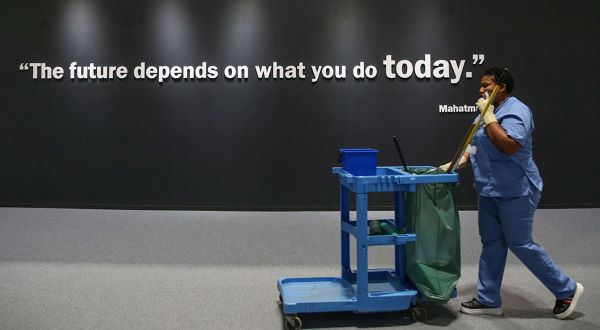A Long and Winding Road: COP 25 end notes
Now that COP 25 has wrapped, it’s worth looking back at what was—and wasn’t—achieved.
If there is one word to sum up what turned out to be the longest Conference of Parties (COP) in UNFCCC history, it’s arguably “frustration.”
COP 25 nearly didn’t happen at all, on account of mass protests in Santiago, Chile, the planned host city; at the last minute, it moved to Madrid, Spain, forcing some who were planning to attend to instead watch from afar. Once they got rolling, the negotiations didn’t land where they needed to, with countries kicking the can down the road instead of agreeing on essential mechanisms to move forward.
Those delegates who did manage to rearrange their travel and accommodation—including 16-year-old activist Greta Thunberg, who made a lengthy detour across the Atlantic Ocean by hitching a ride on a sailboat with a few kind strangers—arrived with lofty goals, understanding that this was the final round of international negotiations before the Paris Agreement holds governments across the globe accountable to their climate commitments as of 2020.
IISD made it to Madrid in one piece. Our Energy and Resilience teams organized and took part in a long list of events, launched new research and toolkits, and even concluded a presentation with a climate rap (we’re still looking for the footage); meanwhile, our Earth Negotiations Bulletin team provided unbiased coverage of the negotiations and side events through their daily reports and analyses, photos, videos and Halfway-Point Webinar (which saw more than 1,000 registrations).
Now that COP 25 has finally wrapped, having stretched two days past its scheduled end date, it’s worth looking back at what was—and wasn’t—achieved. We asked our experts to share their takeaways, including both the highs and lows. The remarks here come from Anne Hammill, director of IISD’s Resilience Program; Jennifer Allan, a team leader with our Earth Negotiations Bulletin; Laura Merrill, Manager of the Global Subsidies Initiative; and Peter Wooders, senior director of IISD's Energy Program, all of whom have been to many, many COPs.

What happened at COP 25 that left you optimistic about the future?
Jennifer Allan: Half a million people marched in Madrid to demand climate action. Because the Paris Agreement relocates responsibility for climate ambition to the national level (countries choose their policies and targets), there is little room for the intergovernmental process to spur action. While the UNFCCC, and particularly this COP, may prove unable to address the climate emergency, the power of people mobilizing around the world in this way can potentially pressure governments to do more at home.
Perhaps counterintuitively, the non-result on Article 6 market mechanisms may be a good thing. Countries that held the line on environmental integrity welcomed no deal as better than a bad deal. There was a concern that the mechanisms could allow countries to count credits created under the Kyoto Protocol toward their Paris Agreement pledges, alongside worries of “double counting” (where the country buying the credit and the country selling the credit would both claim the emissions reduction). Such design flaws would have undermined the ability of Article 6 to spur overall emission reductions.
Anne Hammill: The strong support we received for our work on gender left me optimistic. The approval of a new five-year Gender Action Plan (GAP) by the UNFCCC was one of the few shining lights at this year’s COP—and it’s a plan that aligns with priorities we have been advancing at IISD, especially in terms of ensuring that climate action is gender-responsive. The NAP Global Network hosted a lively debate around whether increasing women's participation in decision making was the key to unlocking gender-responsive adaptation—it got heated! We also co-organized a session at Development & Climate Days to interrogate what, exactly, is meant by the term “gender-responsive climate finance,” as we feel there’s much more to it than what’s normally discussed. We had a huge turnout to launch a toolkit we developed on gender-responsive National Adaptation Plans (NAPs), in collaboration with the UNFCCC’s Least Developed Countries Expert Group and the Adaptation Committee. And this was the first year IISD was at a COP as a member of the Women and Gender Constituency, which has strengthened our connections with organizations advocating for gender equality and women’s rights in climate action and will enrich the work we do moving forward.
"The approval of a new five-year Gender Action Plan (GAP) by the UNFCCC was one of the few shining lights at this year’s COP"—Anne Hammill, Director, Resilience
Overall, I walked away from COP feeling a sense of resolve to charge ahead; despite the lack of overall progress we saw in the climate negotiations, the new GAP—and our work to support its implementation—reflects a commitment we’ve been seeing among partners, such as Jamaica, Kiribati, and Madagascar, to get things done on the ground.
Peter Wooders: On the Energy front, there's a lot to be optimistic about. There was an increasing number of net-zero and similar commitments made by countries, which is key to climate leadership. It was refreshing to hear Danish Climate Change, Energy & Utilities Minister Dan Jørgensen state on several occasions that he did not know how Denmark would meet its 70 per cent emissions reduction by 2030 commitment, but that this wasn’t a weakness—they would find a way. Then there was a huge focus on the just transition away from fossil fuels and into clean energy (renewables and energy efficiency). The debates and discussions at the German Pavilion and elsewhere showed just how sophisticated the understanding of countries was in terms of how to proceed.
It was also great to see a focus now on how building up natural gas infrastructure as coal phases out is no longer the right pathway everywhere—we can jump straight to renewables, with continuing evidence of renewables out-competing coal and natural gas in the markets. The reform of fossil fuel subsidies has become almost a mantra now, repeated everywhere: subsidizing climate change is clearly non-sensical.
Laura Merrill: More organizations and businesses are saying that we need to end subsidies to fossil fuels and shift financing to accelerate renewables and a transition to net-zero-carbon systems. Innovators like Solar Impulse, as well as big intergovernmental organizations like the World Meteorological Organisation and the UN Secretary-General and investors, are calling for action, but so are young people from the Middle East and even Michael Bloomberg. People across the globe are starting to understand the kind of massive swap this is going to require.

(Photo IISD/ENB | Kiara Worth)
What happened (or didn't) that has left you feeling concerned or frustrated?
Jennifer Allan: There is much to worry about, including the future legitimacy of the UNFCCC. Questions of whether this body can truly deliver are growing louder and increasingly difficult to ignore. Parties mandated this COP with a limited set of issues to address, and almost all were technical in nature. Even the best outcome on all of these issues—Article 6, loss and damage, and others—would have proven inadequate to raise ambition. Furthermore, that parties could not agree on how to move forward on the issue of common time frames for Nationally Determined Contributions (NDCs) threatens to undermine the cyclical logic of the Paris Agreement and the ambitious “ratchet-up” mechanism.
Even more frustrating is the ongoing lack of trust among parties. Simple issues, like how to set up a registry for countries’ NDCs and adaptation communications (essentially, a website), proved intractable because of legacy debates over principles. Countries blocked issues of deep importance to one another in adversarial negotiation ploys that do not bode well for building the trust necessary to move forward with collective climate action.
"The reform of fossil fuel subsidies has become almost a mantra now, repeated everywhere: subsidizing climate change is clearly non-sensical." —Peter Wooders, Senior Director, Energy
Anne Hammill: The overall lack of progress in the negotiations has me worried that countries are retreating from each other; that, in this moment where the evidence is clear, where voices demanding action are louder than ever, we cannot see a shared path forward. Beyond this, however, is an unsettling feeling that the global headlines are detracting from the very real progress that's actually happening on the ground. Despite the obstacles being faced, by developing countries in particular, in terms of access to finance and other resources, there is a lot happening that we should heed. Recognizing progress does not absolve rich countries from providing more support.
Much of the Resilience Program’s purpose at the COP was to advocate for National Adaptation Planning. It is our firm belief that robust adaptation planning processes—where climate considerations are firmly embedded in development plans and decisions—are the foundation for effective adaptation action. Otherwise, you run the risk of investing in band-aid solutions. Getting these processes in place takes time, as we're talking about systemic change, yet all we heard at COP 25 about NAPs was that progress was far too slow, that not enough was happening. On the one hand, this message certainly underscores the need to scale-up adaptation support. On the other hand, it can cast doubt on the value of current efforts and on the NAP process itself. We can’t let the need to mobilize more resources take away from the hard-won victories. We must recognise and learn from stories of progress, such as those captured in our Stories of Progress in NAP Processes in 2019.

Peter Wooders: It would be great to see more ambitious NDCs next year, and there is considerable concern that this won’t be the case. My main concern is the lack of urgency. The Production Gap report, which IISD co-authored, shows that existing plans on coal, oil and gas production will take us 50 per cent above the 2°C pathway in 2030 and 120 per cent above the 1.5°C pathway—and the first step when you are in a hole is, of course, to stop digging. Whether we need a strong UNFCCC process to deliver this is perhaps now questionable, but it would certainly help.
Laura Merrill: Actual progress on subsidy reform and correct pricing of fossil fuels this year has been glacial, let alone made mention of in the Paris Agreement. Countries urgently need to share lessons around what works and what doesn’t. Everybody had an opinion at this COP as to why things don’t work when energy prices go up or jobs are threatened. What we need is more understanding of the policy and planning that actually does work to make this transition successful.
You might also be interested in
Nine Wins for Sustainable Development in 2024
Looking back on 2024, let’s take a moment to pause and appreciate the positive milestones of the year. Join us in celebrating the small and big wins for global sustainability.
The Cost of Fossil Fuel Reliance
Government support for fossil fuels reached at least USD 1.5 trillion in 2023, new data shows.
Commission must stop Energy Charter Treaty hijacking EU climate policy
The Energy Charter Treaty allows fossil fuel investors to sue EU member states before international arbitral tribunals to challenge climate mitigation measures. This legal mechanism is increasingly weaponized by the industry, IISD's Lukas Schaugg writes.
Increased Support Needed to Achieve India's Clean Energy Goals
India is on track to achieve many of its 2030 clean energy goals but needs to step up government support measures to accelerate the deployment of offshore wind, electric vehicles, and green hydrogen, according to a new report.
